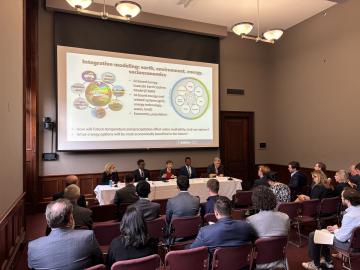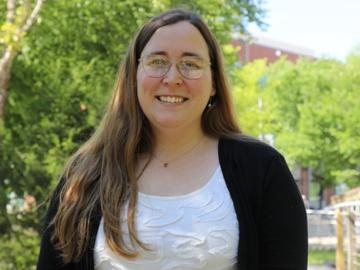
Filter News
Area of Research
- Biology and Environment (43)
- Biology and Soft Matter (1)
- Computational Biology (1)
- Computer Science (2)
- Energy Science (30)
- Fusion and Fission (4)
- Isotopes (17)
- Materials (25)
- Materials for Computing (5)
- National Security (17)
- Neutron Science (11)
- Nuclear Science and Technology (7)
- Quantum information Science (3)
- Supercomputing (55)
News Type
News Topics
- (-) Advanced Reactors (12)
- (-) Clean Water (16)
- (-) Computer Science (111)
- (-) Cybersecurity (14)
- (-) Fossil Energy (6)
- (-) Isotopes (33)
- (-) Microscopy (23)
- (-) Partnerships (36)
- (-) Space Exploration (13)
- 3-D Printing/Advanced Manufacturing (56)
- Artificial Intelligence (77)
- Big Data (45)
- Bioenergy (68)
- Biology (80)
- Biomedical (42)
- Biotechnology (25)
- Buildings (30)
- Chemical Sciences (35)
- Composites (11)
- Coronavirus (19)
- Critical Materials (5)
- Education (2)
- Emergency (3)
- Energy Storage (32)
- Environment (116)
- Exascale Computing (51)
- Frontier (44)
- Fusion (38)
- Grid (32)
- High-Performance Computing (81)
- Hydropower (6)
- ITER (4)
- Machine Learning (37)
- Materials (51)
- Materials Science (55)
- Mathematics (8)
- Mercury (7)
- Microelectronics (3)
- Molten Salt (2)
- Nanotechnology (17)
- National Security (60)
- Neutron Science (82)
- Nuclear Energy (66)
- Physics (34)
- Polymers (9)
- Quantum Computing (35)
- Quantum Science (48)
- Security (16)
- Simulation (42)
- Software (1)
- Statistics (2)
- Summit (40)
- Transportation (30)
Media Contacts

A multi-institutional team of researchers led by the King Abdullah University of Science and Technology, or KAUST, Saudi Arabia, has been nominated for the Association for Computing Machinery’s 2024 Gordon Bell Prize for Climate Modelling.

ThermoVerse and Expanding Frontiers have made strides in energy innovation by securing wins in Phase 2 of the Department of Energy’s American-Made Lab MATCH Prize, a competition designed to accelerate commercialization of national laboratory technologies.

Researchers led by the University of Melbourne, Australia, have been nominated for the Association for Computing Machinery’s 2024 Gordon Bell Prize in supercomputing for conducting a quantum molecular dynamics simulation 1,000 times greater in size and speed than any previous simulation of its kind.

To bridge the gap between experimental facilities and supercomputers, experts from SLAC National Accelerator Laboratory are teaming up with other DOE national laboratories to build a new data streaming pipeline. The pipeline will allow researchers to send their data to the nation’s leading computing centers for analysis in real time even as their experiments are taking place.

Jordan Cannon is CEO of Circular Biosciences, a Cohort 2024 Innovation Crossroads company, a startup dedicated to accelerating bioplastic degradation for more widespread use, easier disposal and reduced environmental impact.

Entrepreneurs, city leaders and community members gathered Oct. 1 at the Mill and Mine in downtown Knoxville for Startup Day 2024, the flagship event of Innov865 Week. Innov865 highlights the efforts of the Innov865 Alliance to develop, support and promote innovation and entrepreneurship in the Knoxville region.

Prasanna Balprakash, director of AI programs for ORNL, discussed advancing climate and weather research through high performance computing and artificial intelligence as part of a September 18 panel for the United States Senate.

Karly Harrod, recipient of the Early Career Competition Laboratory Directed Research and Development award at ORNL, is focused on extracting disease data from reports. Passionate about global health, she looks forward to applying her expertise to climate data within the geospatial science and human security division.
After retiring from Y-12, Scott Abston joined the Isotope Science and Engineering Directorate to support isotope production and work with his former manager. He now leads a team maintaining critical equipment for medical and space applications. Abston finds fulfillment in mentoring his team and is pleased with his decision to continue working.

Katy Bradford is on a mission to revolutionize the construction industry and is the founder of Cassette Construction, a company in the newest cohort of Innovation Crossroads, a DOE Lab-Embedded Entrepreneurship Program node at ORNL. As an Innovation Crossroads fellow, Bradford and her company will receive technical, financial and networking support to successfully advance the company’s products to the marketplace.


